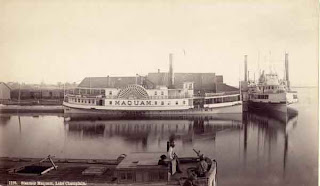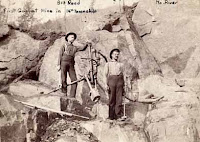 The Adirondack Museum has launched a new online exhibit, “Common Threads: 150 Year of Adirondack Quilts and Comforters” that will share quilts and Adirondack quilting history. The online exhibit includes quilts, text, and historic photographs and is a companion piece to a special exhibition, also named “Common Threads” that will open to the public at the Blue Mountain Lake museum on May 22, 2009.
The Adirondack Museum has launched a new online exhibit, “Common Threads: 150 Year of Adirondack Quilts and Comforters” that will share quilts and Adirondack quilting history. The online exhibit includes quilts, text, and historic photographs and is a companion piece to a special exhibition, also named “Common Threads” that will open to the public at the Blue Mountain Lake museum on May 22, 2009.
The exhibit will include more than forty quilts: historic pieces from the Adirondack Museum’s textile collection, as well as contemporary quilts, comforters, and pieced wall hangings on loan from quilters in communities throughout the region. Demonstrations of handwork will accompany the exhibit throughout the summer. According to an Adirondack Museum announcement:
The Adirondack region has supported an active pieced-textile tradition for over a century and a half. From bedcovers, plain or fancy, meant to keep families warm through long Adirondack winters, to stunning art quilts of the twenty-first century, the quilts and comforters of the North Country mirror national trends and also tell a unique story of life in the mountains. “Common Threads: 150 Years of Adirondack Quilts and Comforters” explores the themes of women’s work, domestic life, social networks in a rural area, generational continuity among women, and women’s artistic response to life in the Adirondacks.
“Common Threads” will include a family-friendly discovery area where kids can explore pattern and design, try simple stitching on child-sized quilt frames, or enjoy illustrated quilt-themed children’s books. The Adirondack Museum has also developed a special “Toddler Tour” of the quilt exhibit “that will lead the smallest visitors on a fun (and fast) search for color, shapes, and animals among the quilts on display.”
Museum Curator Hallie Bond will offer an illustrated Monday Evening Lecture on July, 27, 2009 entitled “Common Threads – Adirondack Quilts Tell Their Stories.” The program will begin at 7:30 p.m. and will be held in the Auditorium.
The Adirondack Fabric and Fiber Arts Festival will be held on September 12, 2009. A celebration of traditional and contemporary fiber arts, the Festival will include demonstrations, a juried artisan’s market, and hands-on activities. In addition, folksinger, song writer Peggy Lynn will offer a special musical presentation, “A Stitch in Time: Songs Celebrating the Art and Heritage of Quilting.”








